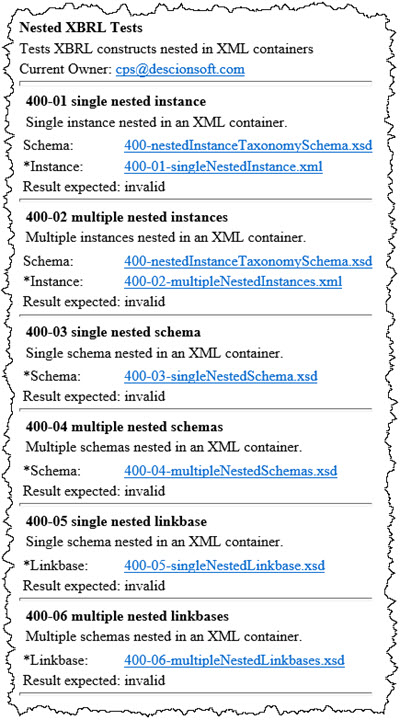Graphs, Nested XBRL, and SBRM
Don't know if people realize this, but you can embed XBRL linkbases within XBRL taxonomy schemas. I have been doing that with my FAC schemas. For example, see this XBRL taxonomy schema with embeded linkbases here.
XBRL Cloud has what they call their "logical model". That comes in the form of an XML Infoset or JSON (I used a .txt file name, but this is JSON). That logical model is what drives the creation of this XBRL Cloud Evidence Package as I understand it.
The XBRL International XBRL 2.1 Conformance Suite has some tests in the 400-misc section that relate to XML containers. This apparently (a) is standard and (b) allows you to put, it seems, an XBRL instance, all associated taxonomy schemas and linkbases, and all XBRL Formulas together into ONE FILE.

So, here is a prototype that I created that uses the SFAC 6 prototype. Here is the XBRL instance, multiple XBRL taxonomy schemas, XBRL Formulas all combined into one file. NOTE that is not valid per the XBRL 2.1 conformance suite yet.
So, this is actually logically equivalent to above and does pull in 100% of the logical information that is necessary from a bunch of different files. Using standard XBRL discovery rules (i.e. Discoverable Taxonomy Set, DTS) all that "stuff" is required to be combined. Software stores all that in memory in order to work with the XBRL-based information.
Essentially, what any of these things give you is a graph that can be accessed using, say XPath, XML Path Language which is a query language for XML nodes in one document or across documents.
Another approach is GraphQL. People seem to love GraphQL. Here is a video introduction to GraphQL. This video explains that GraphQL is essentially an alternative to REST end points for returning information from a web server.
So here is an approach to using GraphQL-LD: Linked Data Querying With GraphQL. This seems to enable the possibility of using GraphQL against an RDF triple store.
Pick your storage mechanism, pick your query language. What makes this work better is if the nodes of the graph are (a) the information you need and (b) logically organized. That is where SBRM comes in.

Reader Comments